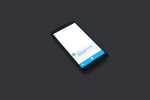Once a person downloads an app, he has to go through a set up experience which we call “on-boarding”. After using Skype, we want to keep the user happy we call it “life-cycle”.
Role
Lead UX Designer
This has been in the making for many years now. It is a good example of how I and the product owner(s) created a product vision that finally came to life. I will show the steps we took.
Product Discovery
Opportunity Assessment
- Exactly what problem will this solve? (value proposition)
While Skype is great at leveraging its strong brand to acquire customers of Skype-to-Skype communication, we are not so good at opening these customers up to other features and services through timely and relevant messaging. As a result, we struggle to build deep long lasting relationships with our customers, relationships that can lead to higher engagement and ultimately better uptake of paid services. - For whom do we solve that problem? (target market)
As a new user I want to be able to get started easily and make my first call right away.
Existing users must be able to discover, understand and try other things on Skype that make Skype better than a phone, in an unobtrusive and relevant way. - How will we measure success? (business metrics)
Increased usage, adoption and awareness of features
Decrease churn in first 7 days after install
Increase NPS score
Decrease Customer Support requests - Product Strategy
A Messaging Platform with shared targeting that is scalable and easy to use across all channels and can deliver all message types (Emergency, Targeted, Event based, Contextual)
The ability to communicate with users (for various reasons) without having Client/Web releases involved
The ability to react quickly to customer behavioural changes, product changes and market conditions with new or alternative messaging
Research
- AnalyticsCrucial 7 days for feature adoption
Skype product features tend to be adopted by customers in the first 7 days after registration, or not at all. (exception is file transfer)  Who pays and stays
Who pays and stays
Multi-Payers – more than one pay product –
Paid Non-Video
Paid & VideoWho does not pay and leaves
Free Video
Free Non-Video
Late Adopters- Customer Insights
User Interviews
Existing user testing reports
Focus groups
Customer Support data

Challenge
I had a set of business goals to create a system that will guide users through their first Skype experience and increases adoption of the new features that are currently promoted via marketing messages.
To focus and to make this achievable I concentrated on a subset of user goals, based on customer support issues, usability reports, Business Intelligence data and experience.
What I found out about users
Myth: Users download Skype to make free calls
Truth: Users download Skype because the want to be able to communicate for free or very cheap, and to do more than they can do via a phone.
Myth: Existing users need to know about new features
Truth: Existing users want to know about features their friends are using when communicating to them
Myth: The more contacts I have the more call / messages I am going to send
Truth: We talk to about 7 people on a regular basis (check out Dunbar’s number)
Try looking at your phone’s recent calls list and count the number of people you call regular… it will not be more than 7. + random calls for pizza and taxi
Validation
I looked through data from Skype Business Intelligence team and through the Insight’s to understand more about the on boarding and life cycle data we had.
As a new user I download Skype because I want to be able to communicate for free or very cheap, and to do more than I can do via a phone.
(I want to be able to do it right away. If I don’t know what to do, I want to know how I can do it.)
Existing users must be able to discover, understand and try other things on Skype that make Skype better than a phone, in an unobtrusive and relevant way.
(I want to know and do more things on Skype, but only if its easy and useful to me
I don’t want to be spammed with too much information
I want to try new things- right away, successfully
I want to try new things free)
Solution
Skype Line – a preset contact in the contact list which delivers relevant messages, users can ask for help in the same way as they interact with their ‘human’ contacts.
Babble Magic – an interactive way of exploring features by guiding user through the UI when user asks for help with a specific feature and trying it out right away
ME2 – a way to learn about features that friends are using. i.e. if a friend sent me a photo but i never used that feature before, add a suggestion next to the photo -“show me how to send pictures”.
After several iterations and eventually being picked up and driven by a different team, SkypeLine has been released under the name of Skype Concierge and resulted in a significant increase of feature adoption.
